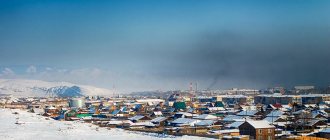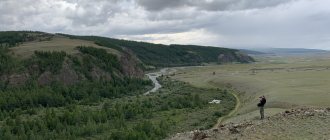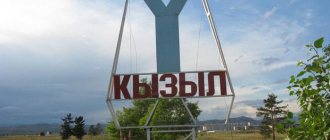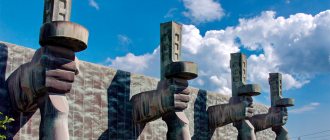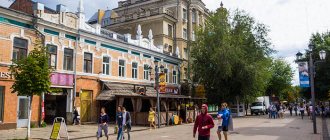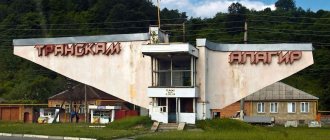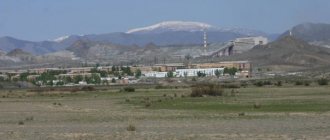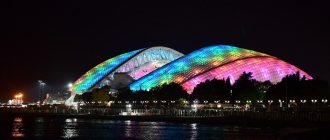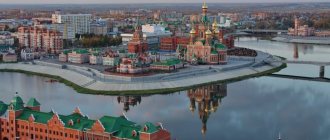The Republic of Tyva is a little-known land of Southern Siberia not only for foreigners, but also for Russians themselves. This is an ancient territory, a special world in which shamanism, Buddhism and Orthodoxy , in which older cultures have not been forgotten. Here, endless green steppes and wild mountains, mounds and megaliths, organically fitting into the unique local landscapes, await the traveler who is not afraid to find himself far from the usual urban comfort.
In terms of cultural traditions and natural features, Tuva resembles neighboring Mongolia
Ubsunur Basin
This natural biosphere reserve is state-owned and is located in the water basin of Lake Uvs-Nur of the same name (Southern Siberia). It is considered a UNESCO heritage site. The reserve is transboundary - located on the territory of not only Russia, but also Mongolia. Founded in early 1993.
The area of the reserve is more than 323 thousand hectares. The territory is divided into 9 separate areas ranging from 800 to 122 thousand hectares.
The reserve is attractive due to its mixture of complex ecosystems. It includes deserts, steppes, alpine meadows, tundra, taiga, and glaciers. The territory contains approximately 80 species of mammals and 360 species of birds. Some animals are endangered.
National Museum named after Aldan-Maadyr
The facility was founded in 1929 and is the oldest museum in Tyva. It is located in the center of Kyzyl (the capital) and occupies a large white building.
The exhibitions occupy 2 floors and are represented by many collections, including ethnographic, archaeological, documentary and written. In the museum you can see Orthodox icons, church books, religious collections of shamanic and Buddhist attributes, household items and art. In total, the museum collections number about 118 thousand items, of which more than 99 thousand exhibits are the main fund. The museum has many branches.
Ustuu-Khuree
This is the largest widely known Buddhist monastery in Tyva. It is located in the Chaylag-Alaak tract, not far from the city of Chadan. Founded more than a century ago in 1905.
The monastery was almost completely destroyed in the 30s of the 20th century, but only at the end of 1999 it began to be restored. Today it is the center of spirituality and statehood of Tuva. Here the foundation of the Tuvan alphabet was laid and the first coin of the Tuvan People's Republic was minted.
An international festival of live music and faith, named after the Ustuu-Khuree monastery, is held annually. It opens with an unusual and colorful ritual procession. There are 4 concerts in one day.
Azas Nature Reserve
The facility is state-owned and is located in Todzhinsky kozhuun. It was founded in early 1985 and occupies more than 300 thousand hectares. The territory has a picturesque topography.
The reserve is located in the Todzha Basin, which belongs to three mountain systems. The territory contains several dozen large lakes, including Many-Khol, Kadysh, Azas (Todzha).
73% of the reserve is occupied by forests. There are about a thousand species of higher vascular plants, as well as bryophytes and lichens. Some species are listed in the Red Book.
The fauna of the reserve is represented by 15 species of ichthyofauna, 51 species of mammals, 230 species of birds. Some species are listed in the Red Book.
Climate
The Republic of Tuva is located in the Tuva Basin and is surrounded on all sides by mountain ranges. Therefore, a sharply continental climate prevails here. In winter there is little precipitation and the air temperature usually drops to -30°C. In summer, the weather in the mountainous areas remains moderately warm, while in the depressions the weather is hot, the temperature rises to +25-35 °C. The most favorable months to visit Tuva are April, May and September.
Buddhist Temple Tsechenling
The facility is located in the capital of the republic. It was founded in 1998 and built in just 1.5 years. The first floor is the residence of the Dalai Lama, and the second floor is a prayer hall, where there is a magnificent altar with magnificent decoration in Tibetan style.
The temple territory includes 8 stupas - symbols of the most important events in the life of Buddha. The building has traditional white walls, an eastern roof, the corners of which are raised upward. You can get to the temple via a wide grand staircase.
Location of the Republic of Tuva and its capital
The territory of the Republic is located in Eastern Siberia, in the very south of our country. The capital of Tuva, the city of Kyzyl, is located just 20 kilometers from the geographical center of Asia. On the southern border of Tuva is Mongolia; on other sides the republic borders on Altai, Khakassia, Buryatia, the Krasnoyarsk region and the Irkutsk region. Most of the territory of Tuva (approximately 80%) is occupied by mountains, the height of whose peaks is from two to three kilometers above sea level. Most of the rivers of the republic belong to the Yenisei basin. At the source of the Big Yenisei River there is the Derby-Taiga basalt plateau, where there are sixteen volcanoes that are considered extinct.
Buddhist prayer drum
This attraction is located on the main square of the capital of Tuva. It was officially opened in the fall of 2006. The drum was cast from copper in one of the Indian monasteries - funds were collected by city residents. The Tuvan Kamby Lama took part in the consecration ceremony.
More than 115 million sacred chants are left inside the drum. It also contains several million mantras of His Holiness the Dalai Lama and Lama Tsongkhapa. Today this prayer wheel is the largest in Russia.
Holidays in Tyva
When going to Tyva, you should never trust the maps. A distance of just a few kilometers can in fact turn out to be a real adventure for the whole day, or even two.
It is interesting that for its fellow citizens Tyva is much more unknown, incomprehensible and distant than for foreigners. The uniqueness of the local culture delights and attracts tourists from all over the world. Some foreign tourists, having once visited Tyva, stay here forever.
At the same time, getting to Tyva is not so easy. Krasnoyarsk taxi drivers, for example, can easily refuse even a tempting bonus for a trip to Kyzyl. There was a time when Buryat guides took tourists only to the border with the republic, leaving them to continue their journey on their own. Today the situation has become better, of course. But the crime statistics of Tuva still look frightening, and drunkenness is at the saddest level.
But you are guaranteed to get incredible pleasure and a lot of positive emotions from your trip to Tyva if you don’t forget about local traditions and some tips for the trip. This ancient nomadic people with their traditions, fantastic throat singing skills, colorful shamans and unique holidays may turn out to be the most friendly and hospitable.
The website Tur-Katalog.ru has useful articles about other amazing holiday destinations in Russia:
- Rest on Lake Seliger;
- Rest in Belokurikha;
- Volcanoes of Kamchatka;
- City of the Dead in Ossetia;
- What to see in Altai;
- Where to relax in Karelia.
Aldyn-Bulak
The name of this ethnocultural complex is translated as Golden Spring. It is located in the Tandinsky district on the banks of the Yenisei. The project of the complex is a model of the Universe. The role of the Sun and planets is played by yurts, which are located according to Feng Shui.
The complex was opened in March 2011 with the aim of reflecting the national color of Tuva. It contains several ritual sites, including the Shaman's Place, the Heavenly Gate (Buddhist arch), the Sulda banners (worshipped by men), the Tojin tents, and the fire pit. There are also yurts for living, a parking lot, a sports ground, viewing gazebos, a bathhouse and a sauna. The yurts are decorated in the style of traditional Tuvan life and the wealth of Scythian times.
Bor-Bazhin (Por-Bazhin)
Translated, the phrase means “clay house.” Today these are the ruins of a fortress that was built in the 8th century. The facility is located on an island in the middle of Lake Tere-Khol.
Once upon a time it was a regular rectangle with a clear internal layout - a central structure and a system of courtyards. The purpose of the fortress has not been clarified, but this mysterious object is often mentioned in the oral folk art of Tyva. The restoration of the fortress is planned.
Lake Tere-Khol and Por-Bazhyn fortress
Lake Tere-Khol is located in the mountains, not far from the border of Mongolia. In the 17th century, the ruins of an ancient fortress were discovered in the middle of the lake, which local residents called “Por-Bazhyn” (from the Tuvan language - “clay house”).
Previously, there was no lake in these places. The reasons for its occurrence are unclear. There are several legends telling about his education. One of them says that in ancient times Elchigen Khan lived here. One day he saw water flowing from a well located near the fortress. Fleeing from the water that was rapidly flooding the surroundings of the fortress, Elchigen Khan exclaimed: “Ter Khol!”, which translated means: “This is a lake.” This is where the name “Tere-Khol” came from.
The scientific version tells us that earthquakes, which previously occurred quite often in these places, caused the disappearance of underground sources feeding the lake. Perhaps, during one of the periods of “disappearance” of this reservoir, the Por-Bazhyn fortress was erected. This is also confirmed by traces of the road at the bottom of the lake.
The Por-Bazhyn fortress occupied almost the entire island. It had an original architecture, representing a rectangle oriented to the cardinal points. Behind the high fortress walls, on the territory of the fortress there was a labyrinth of various buildings. Near the eastern wall, in front of the palace building, there was a large square. The palace itself consisted of two buildings, possibly connected by a covered walkway. There were unique frescoes on the outside of the walls.
Due to its inaccessibility, the fortress was unknown to researchers for a long time. Scientists date the emergence of the fortress to the 8th century. The exact purpose of the fortress is not clear. At first it was believed that the settlement was a monastery, but this version was abandoned. Most likely, the fortress was built as the residence of the Uyghur kagan (khan, head of state). According to legend, the dungeons of the Por-Bazhyn fortress hide countless treasures. But so far no evidence of this has been found.
Buddhist niche of Sume
This facility is located on the left bank of the Chaa-Khol River near the village of Urbyun. You can get into the niche by climbing 4 m up the slate steps at the foot of Mount Sume. The monument dates back to the 13th century.
The niche is called Churumal-bargannyg, it is carved into the rock. Its height is only 1 meter, width 0.6 m, and depth 0.86 m. The back wall is represented by gray stone, where the ancient master carved a bas-relief image of Buddha and two bodhisattvas. The niche is framed by a grid of red strokes.
The site is accessible to tourists only once a year, when water is released from the Sayano-Shushenskoye Reservoir. The rest of the time the niche is hidden under water.
Mount Khaiyrakan
This mountain is sacred and is located 100 km from the capital on the left bank of Ulug-Khem. Its absolute height is just over a thousand kilometers.
Mount Khayirakan is very revered by both shamanists and Buddhists. Shamans perform rituals at its foot, and the Dalai Lama XIV in 1992 chose it for its special power and consecrated it.
Many legends and tales are associated with this mountain. Today it is one of the points of tourist routes in Tyva. In the spring it turns purple due to the flowering of buttercups and wild rosemary, but in the summer everything burns out.
Tips for a trip to Tyva
Your holiday in Tyva will be more comfortable and safe if you listen to the following tips:
- If your trip around the republic is planned for more than 10 days, be sure to register at any local police department;
- Avoid Tuvan discos, where the concentration of drunk people is especially high;
- At night and generally late in the day, it is better not to leave the house without a guide from the local population;
- You should not take large amounts of cash with you;
- Show friendliness and sincere interest in the traditions and culture of the population of the republic;
- Always leave a couple of backup options just in case. If, for example, your hotel reservation is lost somewhere and the taxi never comes for you.
The listed tips are based on the national characteristics of the Tuvans. They are a warlike nomadic people. It is not inherently binding, which should always be taken into account.
And like most Siberian peoples (due to physiological characteristics), Tuvans are prone to addiction to alcohol, from which they become aggressive.
Lake Dus-Khol
This lake is also called Svatikovo. It is located in Tandinsky kozhuun, 45 km from Kyzyl. The area of the lake is only 0.55 square meters. km. It has an oval shape and relatively flat banks; there is no woody vegetation.
There are several sanatoriums on the lake, and a camping base is also organized. It is popular for recreation among residents of the east of the republic. More than a thousand people come here in the summer. The lake attracts with its healing water - its properties are similar to the water of the Dead Sea. This lake is so salty that you can easily lie on its surface.
Mount Kezhege
The facility is located near the Mongolian border in Erzinsky kozhuun. The name of the mountain translates as “man’s braid.” It is shaped like a ring and is notable for its narrow labyrinth of stone city streets, reminiscent of old Rome. Each street is a high, narrow chasm, at the end of which there is a stone altar for offerings to the spirits.
It is believed that the mountain is the habitat of the patron spirits of shamans. According to one legend, wishes can come true in this place; according to another, the shrines of Buddhist temples in Tuva, which were destroyed during the revolution, are hidden here.
There is also a legend according to which one hunter wounded a wild goat, and while chasing it, he lost his man’s braid (a symbol of courage) and died. Because of this legend, hunting is prohibited here.
Kurgan Arzhaan-1
The mound is a royal burial place of the Scythian period of the 8th-7th centuries BC. This is the largest such structure in northern Asia. Its excavations were carried out in the 70s of the last century. A grandiose wooden structure with a log ceiling was discovered - a central log house and 70 secondary log buildings. Its construction took approximately 5 thousand massive larch logs.
The king and queen were buried in the central frame of the mound, and around them were 16 people and more than one and a half hundred horses. Gold and silver jewelry and unique items were found.
Sights of the capital
Obelisk "Center of Asia", museums
On one of the capital streets of the republic there is a twelve-meter obelisk, on the pedestal of which rises a globe with a spire. It symbolizes the center of Asia, as evidenced by the text embossed in three languages - Tuvan, Russian and English. The “Center of Asia” is located at the point of the geographical center of Asia, where the Big and Small Yenisei merge with the outlines of mountain ranges visible on the opposite bank.
Not far from the obelisk, on one of the quiet, cozy streets of Kyzyl, there is the Tuvan Republican Museum of Local Lore named after Aldyn-Maadyr. Translated from the Tuvan language, this phrase sounds “in the name of sixty heroes.” The museum was named so in memory of sixty Arat shepherds who rebelled against foreign invaders and local Tuvan feudal lords. However, the rebellion was suppressed, and its participants were brutally executed. Despite the defeat, this uprising played a significant role in the subsequent struggle of the Tuvans for their freedom and independence. The capital's museum was named in honor of the rebel braves.
The museum exhibition has a huge collection that covers the centuries-old history of Tuva, from the Stone Age to the present day. The museum exhibits tell us about the period of prosperity and decline of Ancient Tuva. The museum's collection contains rare items: bronze mirrors and daggers; gold and silver jewelry; quivers made of leather and birch bark; and many other exhibits. All archaeological rarities stored in the museum were found on the ancient burial mounds of Tuva. Many of the treasures found are sent to the St. Petersburg Hermitage for the purpose of more detailed study. Panoramic photographs hanging on the walls of the Tuvan museum tell tourists about the excavation process and valuable finds.
Also, tourists and guests should visit the capital's museum of the artist N. Rusheva, the museum of political repression, the local philharmonic and the house of folk art. For art lovers, the Musical and Drama Theater named after. Victor Kok-Ool hosts performances in Russian and Tuvan languages.
Lake Shara-nur
The object is often called Yellow Lake. It is located in Tes-Khem kozhuun, just 5 km from the Mongolian border. The lake is called Yellow because of the mass of buttercups blooming on its shore.
The lake is located in the mountains, but has a shallow depth, so it warms up quickly in the summer. People are attracted here not only by warm water and nature, but also by healing mud. It contains many mineral components that are especially beneficial for the cardiovascular system, skin and musculoskeletal system.
Another interesting fact about the lake for tourists is the legends. According to one of them, the hunter saw three swans who turned into beautiful girls. He stole clothes from one of them, and she remained a human on earth, fell in love with him and gave birth to many children - the ancestors of the Buryat people.
Uttug-Khaya
I call this mountain Leaky Rock because of the through passage connecting the western and eastern slopes. There are other names for the object - the Watchtower of Genghis Khan and the Mountain of Desires.
In the center of the through passage there is a narrow hole through which you can get to the southern slope. According to legend, a person who overcomes this obstacle will have their cherished desires fulfilled.
Lake Kara-Khol
The object is also called Black Lake (literal translation). It is located in the Bai-Taiginsky kozhuun (Western Sayan). The lake is a regional natural monument and is considered one of the most picturesque places in Tyva.
Its absolute height is about 1.5 km, and its area is 16 square meters. km. The lake is called black because of the reflection of the mountain ranges, giving the water its corresponding color. There is a small waterfall nearby.
The lake attracts not only with its views, but also with the opportunity to fish - grayling is found here in abundance.
Usinsky tract
It is a picturesque route through the mountains, one of the most interesting roads in Siberia. The road running from north to south allows you to admire the changes of broad-leaved taiga and plains with endless fields, mountain passes with serpentines and loops of the Sayan Mountains and endless steppes. On the border between Khakassia and Tyva there is one of the Western Sayan ridges - the Ergaki Natural Park , called the “pearl of Siberia”.
Ergaki Park, Three Bears Mountain
Mugur-Sargol and Mugur-Sargol sanctuary
This tract is difficult to access and is located on the banks of the Ulug-Khem. The petroglyphs (pisanitsa) of this place date back to the Bronze Age. There are many masks, images of chariots, and wild ungulates carved into the rock. There are about 250 drawings in total.
The Sayano-Shushenskoye reservoir was supposed to hide the petroglyphs, but 50 slabs survived. They were taken to Kyzyl.
Kyzyl
In the very center of the republican capital, on the central city square of Arata, there is a Buddhist prayer wheel and a music and drama theater. Also in the central part of Kyzyl are the State Philharmonic of the Republic, the House of Folk Art and other cultural institutions. Small museums are also interesting. For example, the Museum of the History of Political Repression, the museum of the talented young artist Nadya Rusheva.
Buddhist prayer drum
At the Aldan-Maadyr National Museum you can admire the richest collection of archaeological finds: “Scythian gold”, artifacts of the world famous mound Arzhaan-2. Since 2008, the museum has been located in a modern building, which is considered one of the most beautiful in the city.
The “Center of Asia” stela on the Kyzyl embankment is a symbol of Tuva and its capital as the geographical center of Asia. Located at the confluence of the Small and Large Yenisei, the obelisk attracts the attention of many tourists, as does the Buddhist Stupa of Enlightenment located near the airport. The city has several significant monuments: to soldiers of the Great Patriotic War, a monument to the First Russian teachers of Tuva, victims of political repression, and the Tuvan shepherd-livestock breeder Kadarchy.
Monument to Kadarchy
Not far from the city there is an observation deck “Mountain of Love”, which offers a magnificent view of the city. It is believed that every visitor to this hill gets rid of all sins and cleanses their soul and body. On the right bank of Ulug-Khem you can admire ancient rock inscriptions and drawings.
Cheder Resort
The object is located within the Kyzyl kozhuun. Tourists are attracted here by medicinal table waters, brine (a solution of highly concentrated salts) and mud. The salinity of the lake is close to 200%.
The depth of the lake is only 1.5 m, and the area is 5 square meters. km. The reservoir is attractive not only for its healing properties, but also for its reddish tint. Salt deposits are clearly visible along the shores of the lake.
Stone idols
The ancient history of Tuva is found in the steppe part of the republic. Stone idols towering over the area depict local deities or great leaders of Tuvan tribes. These sculptures are approximately two thousand years old. Tuvans believe that idols have energetic power and can not only help, but also harm a person.
Kizhi-kozhee Bizhiktig-Khaya
Arzhaan Choigan
This healing source is difficult to access, but the most famous. It is located in the extreme northeast of Tuva (Eastern Sayan). Mineral waters flow out along the banks of Arzhan-Khem, a small mountain river, the right stream of Izig-Sug.
The number of indications for the use of this healing source is large. The composition of its waters is close to the Kislovodsk waters.
Lake Sut-Khol
This lake is also called Molochny. It is located in Sut-Kholsky kozhuun at an altitude of 1.8 km above sea level. The lake got its name because of the clouds and rocks reflected in it. Its peninsulas protrude deep into the water, creating bizarre shapes.
The lake is attractive with its clean air and the surrounding silence. In summer there are many tourists with tents, but the reservoir is considered sacred, so you cannot swim in it (and the water temperature of only 4-5 degrees will not allow this).
According to legend, there lived an old witch on the shore of the lake, who once threw a whole vat of milk into the water. The next morning the pond became snow-white, and the cows, after visiting the local pastures, gave milk as thick as cream.
The Republic of Tyva is a unique place. There is amazing nature here, many cultural objects, museums, monuments, objects of historical significance, and healing lakes. The sights of Tuva are especially interesting for residents of European cities - life and religion here have significant differences.
How to get to Tuva
The most convenient way to get to Tuva is through Abakan. Let's say that Aeroflot and Sibir fly direct from Moscow to Abakan.
Air tickets to Moscow Abakan are offered cheaply by Aeroflot; flights to this direction are a little more expensive for S7.
Tickets to Abakan
| Where | departure date | Return date | Find tickets |
| Krasnoyarsk | May 4, 2022 | May 6, 2022 | Find from 4 825 |
| Novosibirsk | February 11, 2022 | February 12, 2022 | Find from 11,856 |
| Tomsk | July 22, 2022 | July 24, 2022 | Find from 14,246 |
| Ekaterinburg | April 28, 2022 | May 3, 2022 | Find from 14,258 |
| New Urengoy | March 3, 2022 | March 9, 2022 | Find from 16,374 |
| Nizhnevartovsk | April 8, 2022 | April 11, 2022 | Find from 16,628 |
| Moscow | May 1, 2022 | May 4, 2022 | Find from 16,711 |
| Novokuznetsk | February 21, 2022 | February 27, 2022 | Find from 16,956 |
| Kemerovo | February 13, 2022 | February 19, 2022 | Find from 19,073 |
| Surgut | February 9, 2022 | February 13, 2022 | Find from 19,300 |
In Abakan you will have to transfer to a regular bus, which can take you to Kyzyl once a day - at 19.00. There are about 400 kilometers between the cities, the ticket costs about 500 rubles. Or take a minibus, which goes to the city of Kyzyl (Republic of Tyva) much more often.
If you decide to fly to Krasnoyarsk, and from there get to Kyzyl, you can also take a bus. It runs twice a week – on Fridays and Sundays, at 9.25. A ticket will cost approximately 900 rubles.
Flights to Krasnoyarsk
| Where | departure date | Return date | Find tickets |
| MTG | February 24, 2022 | February 28, 2022 | Find from 4 508 |
| Kemerovo | March 18, 2022 | March 21, 2022 | Find from 4 560 |
| Abakan | April 22, 2022 | April 25, 2022 | Find from 4 825 |
| Barnaul | February 15, 2022 | February 19, 2022 | Find from 4 825 |
| Irkutsk | April 11, 2022 | April 15, 2022 | Find from 6 110 |
| Novosibirsk | March 16, 2022 | March 18, 2022 | Find from 6 110 |
| Novokuznetsk | March 10, 2022 | March 13, 2022 | Find from 6 190 |
| Tomsk | March 5, 2022 | March 8, 2022 | Find from 6 345 |
| BARREL | February 10, 2022 | February 14, 2022 | Find from 6 370 |
| Ulan-Ude | March 6, 2022 | March 10, 2022 | Find from 7 400 |
If you travel to Tyva by your own car, you should never miss the opportunity to take a ride along the picturesque Usinsky Highway, which starts in Minusinsk and continues through the city of Kyzyl all the way to the border with Mongolia.
Along the Usinsky tract to Tyva
By the way, in the town of Erzin there is a border crossing to Mongolia, which is still closed to foreigners. There are no queues here, and border guards only allow Russians and Mongolian citizens through.
